#SheepHead
Explore tagged Tumblr posts
Text

Spontaneous book 2 reveal
286 notes
·
View notes
Note
hi i saw a post about the fish playing with the human child and even though your addition to that post is 3 years old by now i would love to hear more about ftm sheephead fish :3 (no pressure btw!)
Fish curiosity, in my inbox?? It's more likely than I think, apparently! xD
First off, there's actually multiple fish dubbed 'sheephead'! There's the sheepshead- note the extra S in there- and they look like this:
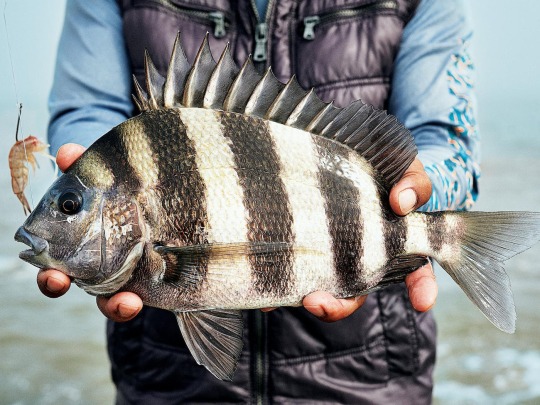
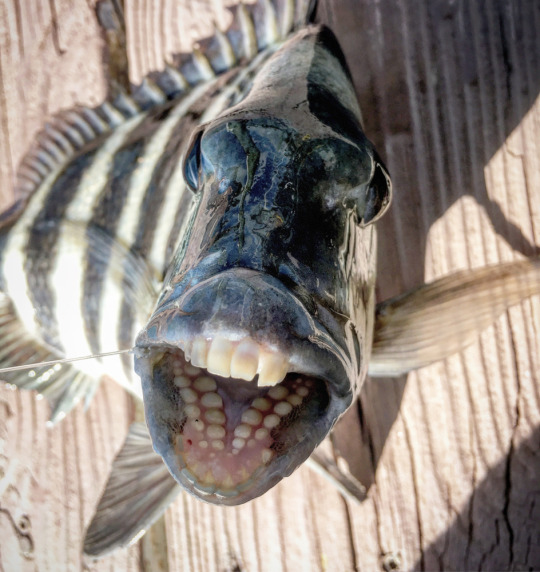
And yes those are their teeth. Horrifying tbh, but they're very good at what they do- crushing invertebrates and other shelled snacks! They're an Atlantic species that sticks to temperate and warmer waters, and they max out at about half a meter in length.
That's not the fish we're talking about today. The focus of today is the California sheephead wrasse- note the lack of a second S- also known as the 'sheephead' for short. Not confusing at all! We definitely don't bash our heads into walls over the naming conventions and lack of record-keeping of our scientist predecessors.
THIS is the sheephead wrasse, the species of the lovely and now Tumblr-famous Red! :D With a length of up to a FULL meter, they're a whole different size class of fish! They can be found along the west coast USA from the Baja Peninsula all the way up to Monterey, and dwell almost exclusively in kelp forests and nearby environments. I will use one of Red's pics as an example of female coloration-
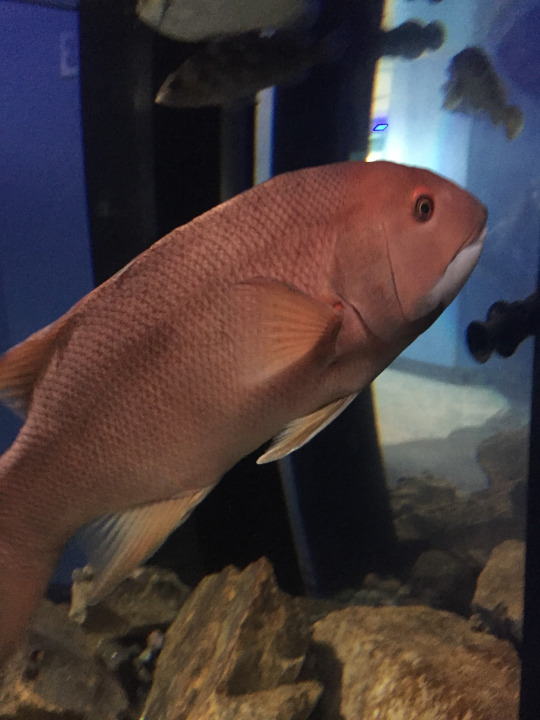
The lighting isn't great but you can see how her body is streamlined, and besides the white underside of the jaw, has a salmon-pink coloration! Females can be pink or a dull silver-beige. And much like other large marine wrasse, MALES have a drastically different appearance.
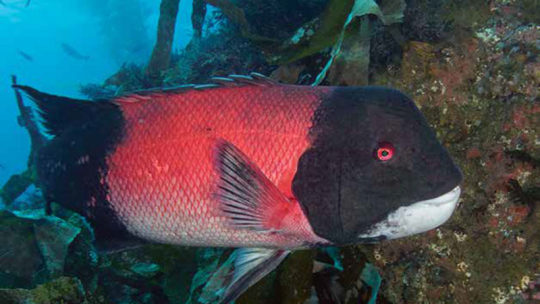

This thing is built like a damn tank!! Sheephead are a species of wrasse that shift colors to gain those striking black scales and physically bulk up when becoming males- because guess what? ALL OF THEM ARE BORN FEMALE! By default, all male California Sheephead are FTM trans :) They use that bulky head and extremely tough set of jaws to not only hunt their preferred prey- mollusks, gastropods, and bivalves, etc- but also to bash and chomp down on rival males. This one has won many battles, look at that scarred up muzzle!
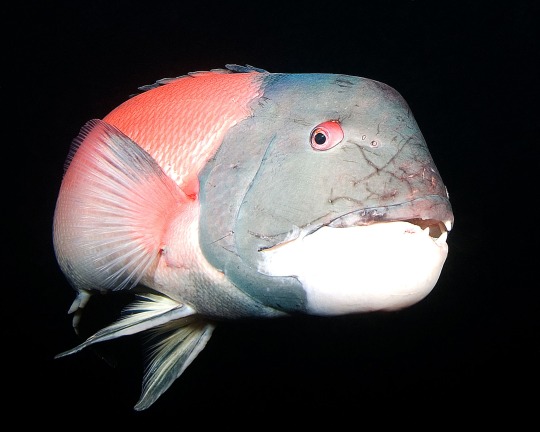
The sex change is determined by several factors, as it's not guaranteed all sheephead will eventually become males. Because sheephead school in a harem system- many females to very few males- in order to maximize pressure of stronger offspring, the biggest and healthiest sheephead male will drive out competition from the school. Naturally, a sheephead that lives longer and gains a greater size will have a much higher chance of shifting from a female to a male, if the conditions are right. Stress induced from competition can suppress the hormones that stimulate this transition in females, so they're less likely to gain size and shift from female to male if there's already strong competition taking place. However, in the event there are too few males to mate with the females, or no males present at all, the biggest female will start transitioning to fill the empty slot! It's a long process that can take as few as a couple months, or up to years, depending on resources available.
Conversely, if there are TOO MANY males, they can revert back into females! This process also takes a long time, and is a lot more rare to witness, especially because right now male California sheephead in particular are being spear-fished into becoming an Endangered species :c Sheephead adult males in good condition are considered a trophy animal in spear-fishing and similar marine trophy hunting off the West coast, and because males in particular are being targeted, the gene pool is being reduced when it wrecks the harem structure of schools.
As a fun fact- they're also an incredibly smart fish, and can form relationships with humans, as demonstrated with me and sweetiepie Red cx There's many documented cases of large marine wrasses forming long-term friendships with divers! Here's a humphead wrasse that made friends with a diver she learned would crack snails open for her with a hammer:
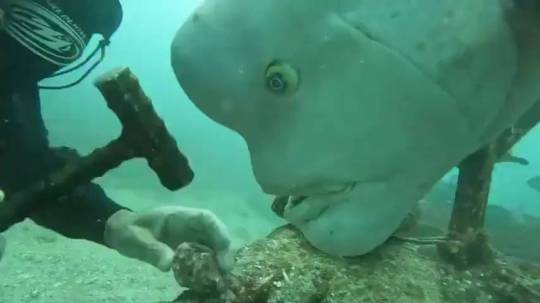
I don't work at the facility with Red anymore, but I currently work with two unnamed adult male sheephead, and once again they both like me and seem to despise all my coworkers, even if I never had the opportunity to train them like I did with little Red xD They pick favorites I guess? Now if only I could make friends with the garibaldi...
574 notes
·
View notes
Text
Fish of the Day
Today's fish of the day is the California sheephead!

The California sheephead, as some of you who have been here since the early days will know, happens to be the first ever fish I wrote about for fish of the day back in January 2022! Known by the scientific name Bodianus pulcher, (formerly Semicossyphus), this fish is a species of wrasse in the Pacific. Found along the coast of California and Mexico, stretching from Monterey Bay California to the Gulf of California. They live along the kelp forests common in this area. Although, there are populations living along rocky reefs and sandy seabed areas. The fish are highly territorial over their home, and only settle in a very small refuge area, which they protect. These areas and the cycle of migration with the California sheephead are shaped almost entirely by light levels, as they travel between a refuge area and a foraging area throughout the day, and then when spawning these fish travel to a breeding area. This is why some issues have arisen due to overspilling light pollution by humans.

Their diet consists primarily of sea urchins, although they also prey on crustaceans, mollusks, and other fish. Their role in the ecosystem of kelp forests can not be understated, which is why the overfishing of them by humans is such a problem. This is because the overabundance of urchin in an area can decimate entire kelp forests at a rate of 30 feet a month in herds. Their diet of urchins allows these fish to get as large as 3 ft in length. Despite their large size, these fish are regularly predated on, primarily by sharks in the area. The California sheephead can warn other fish in the area of their plight however, damage released chemical cues come forth once the skin is ruptured, informing other fish in the area. These chemical cues are not always perfect however, as fish infested with parasites reduces reliability of these cues.

California sheephead, as like many wrasse, are born female and can morph into functional males throughout their lifespan, called Protogynous sex change. This change is moderated by a steroid hormone, and is undertaken by the largest and best fed individuals in an area. Sheephead are hermic spawners, and males have a group of females of which they protect and breed with. When the male for a group of females passes away, the largest female will morph into a male form and take the role. This can take anywhere between 2 weeks or several months. The mating season for these fish is between June and September, and the male will lead all his females in a circular pattern, releasing eggs and sperm. Females during this time can release as many as 130,000 to 375,000 eggs in a day, which will hatch into planktonic larvae. They will continue life as larvae for 34 to 78 days, before settling in a shallow reef and growing as normal. By the time they reach an age of 4 and a size of 10 inches, the fish are ready to spawn, although this is variable between populations. These fish can live upwards for 20 years in the wild, and as long as 50 in captivity, living through tens of breeding seasons, and producing hundreds of children.

That's the California sheephead everyone! Have a wonderful day

#California sheephead#sheephead#wrasse#California#fish#fish of the day#fishblr#fishposting#aquatic biology#marine biology#freshwater#freshwater fish#animal facts#animal#animals#fishes#informative#education#aquatic#aquatic life#nature#river#ocean
35 notes
·
View notes
Text
MWAHAHAHAHAH ITS FINISHED AND I CAN USE CAPCUT EASILY NOW!!!!!
anyways this scene between sheep and whimsy made me sad at the end i love them they need to work out their issues
gift 4 u, because ur awesome, @beefscrap

18 notes
·
View notes
Text
day 3 - wrasse
this guy is sooo freaky looking i respect it
asian sheephead wrasse for you!
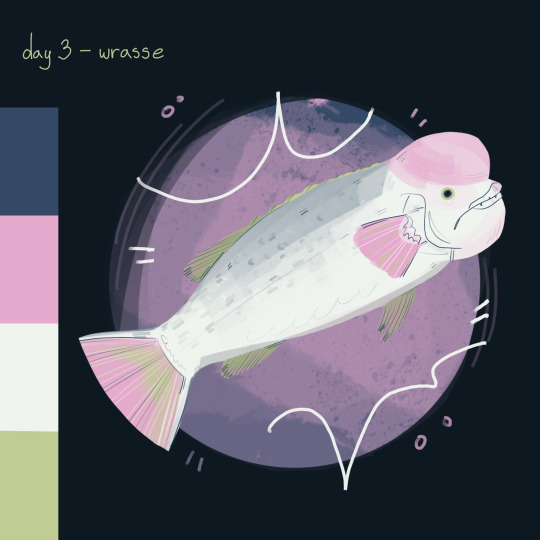
26 notes
·
View notes
Note
If you haven't done it yet I'd love to request the California Sheephead! It's one of my favorite fish!

fish 82 - california sheephead
#fish daily#fish#california sheephead#sheephead#drawing#i swear yall are fuckin with me now bc i got two requests for this after talking about how much they scare me on stream
108 notes
·
View notes
Photo


Lil babby prints of a big ol’ wrasse This is my second linocut, but it’s better than the first and that’s progress :V
#wrasse#sheephead#California Sheephead#fish#marinefish#california wildlife#kelp forest#linocut#block print
19 notes
·
View notes
Text
FBFKDHDKDB
okay Sheephead! king!
With its powerful jaws and sharp teeth, the California sheephead is an incredible fish that can cut through the mightiest sea urchins and protect kelp forests!
Did we mention they also sleep in a mucus cocoon at night? 👀
13K notes
·
View notes
Text



more fish patches :-) new addition of the california sheephead for pride
100 notes
·
View notes
Text

Another! Finally redid Sheep’s ref
Original design by Hologirl1232 on TH (ref by me)
266 notes
·
View notes
Note
OH MU GODDDD LUUYGGDDFF
A FULLBODY?! I’m so spoiled. The way you did his teeths are SO CUTE. As well as the paws/talons… ur style for them is adorable. THE POSE IS FANTASTIC very Sheepish. I LOVE the shapes you used! His lil skinny legs are on point. And his expression 😭 omg. Every detail of his design is perfect?! I like how you did the glow scales a LOT (without the line art!)
I DIDNT KNOW U KNEW OF MY OCS OR ANYTHING ?!2? uuaaaghhh TYSMM
Ougg I saw you had requests and I wanted to offer one of my ocs !! Sheephead

Ty for the opportunity 💥

Here is your boi !!
I loved drawing this, homie looks so chonk😭
I bloody adore all the lil sheepy details on the design so I played around with the general sheepy shape language :3
They’re processing things👀
Thank you so much for the request!! I adore your art and OCs so much, you’re a big inspiration😭💞
124 notes
·
View notes
Note
i need pics of red pls
This question actually made me panic-search my phone, because I was terrified I'd lost those pictures in a recent phone debacle- but by sheer luck, I still have them!! :D
Behold, the girl herself!
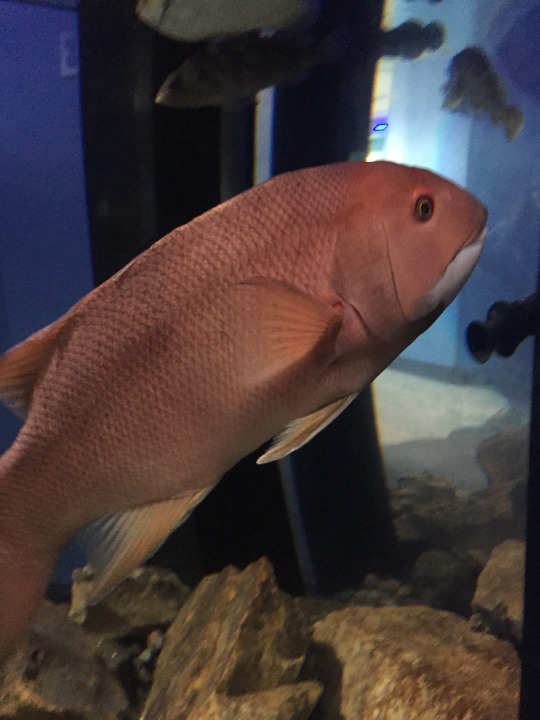
It's been a long time since I took these pics, so the color and quality aren't amazing on my old phone camera, and she's likely MUCH bigger now- maybe even transitioned into being a male!
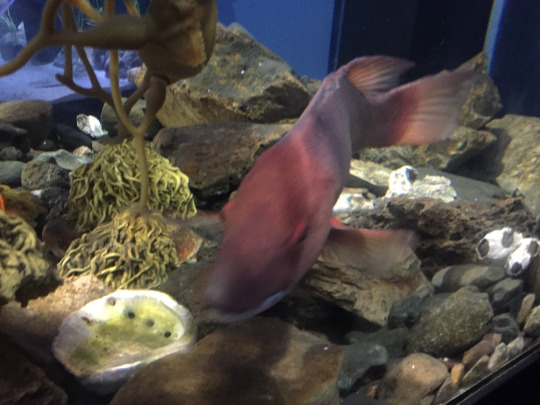
This is her following me around outside feeding time xD

And her preemptively doing the surface-munch because she knew it was lunchtime once I showed up lmao. That rockfish in the background isn't impressed, but it lets them eat in peace.

And one last beautiful mugshot of those kissy lips <3 She had gorgeous pearly white teeth behind that smile >u< Red liked to try to peek at me through windows in the condensation when it got really hot outside.
2 notes
·
View notes
Text
Wet Beast Wednesday: California Sheephead Wrasse
A lot of people through history and the modern day have an overly simplistic view about sex, both in the sense of biological sex (that is, what gametes something produces) and sex as in the act of mating. A lot of people think that sex is just a strict binary between males and females, but nature is far more diverse and varied than that (even in humans. Intersex people do exist after all). Today I'm showcasing one of the animals that completely goes against the alleged sex binary: the California Sheephead Wrasse. And yes, this is a pride post.
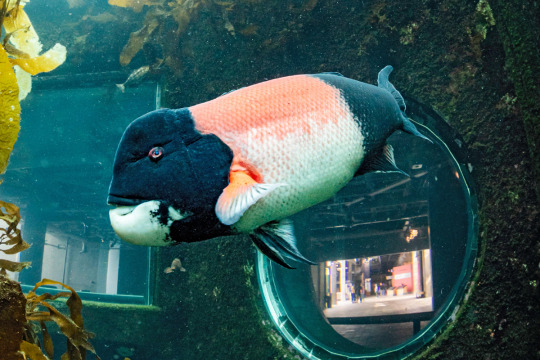
(Image: a male California Sheephead Wrasse in a tank in the Monterey Bay Aquarium. It is a large fish with a bulbous head. The head and tail are black, midsection is pink, and the belly and chin are white. End ID)
The California Sheephead (Semicossyphus pulcher) is a large fish in the Wrasse family of Labridae. They are sexually dimorphic, with the males and females appearing distinct from each other in size, shape, and color. Males are larger than females, reaching up to 91 cm (3 ft) and 16 kg (35 lbs), though there is quite a bit of size variation based on food availability. They have flatter faces than females thanks to a bulbous bump on the forehead. This lump is the namesake of the fish, since it allegedly make it look like it has a sheep's head. I personally don't see it at all. Males have black heads and tails with a white chin and underbelly and pink midsection Females are smaller and colored silvery to a dull pink all over except for their white chins and underbellies. There isn't really a maximum size or weight for females for reasons I'll get into later. The fish have large canine teeth that protrude from the mouth and modified throat bones that form a grinding apparatus called the throat plate.
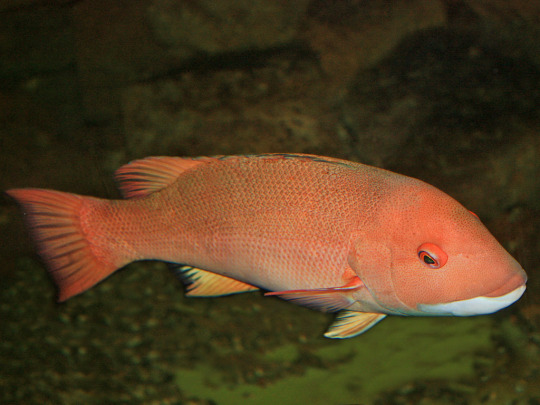
(Image: a female California Sheephead. It has a less bulbous head than the male and is a pale pink all over, except for the white belly and chin. End ID)
Sheepheads, like many wrasses, are sequential hermaphrodites. A sequential hermaphrodite can transition between sexes during its life (as opposed to a simultaneous hermaphrodite, who can produce both sperm and eggs at the same time). Every California Sheephead is born female and some will become male later in life, making them protogynous. Protogyny is the most common form of hermaphroditism in fish, with over 75% of known sequentially hermaphroditic fish species being protogynous. This transition is a one-way process, males will not turn back into females. The transition is triggered by a number of factors, primarily size and the local availability of males. If there are not enough males in the area, the largest female will transition to male to fill the role. This transition takes between 2 weeks and a few months depending on availability of food and other conditions (temperature seems to play a role) and the fish will be capable of producing sperm before fully assuming the male morphology.
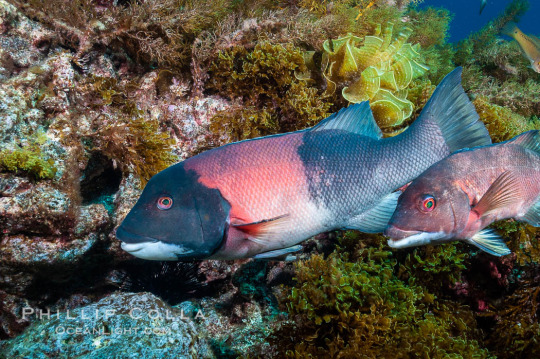
(Image a male and female Sheephead swimming next to each other. The female is roughly half the size of the male. End ID)
During mating season (July-September), males will pick a territory and claim all nearby females as mates. A younger male without a territory may challenge an alpha male to try to claim his territory. These fights are often resolved with threat posturing, but if neither male backs down, they will fight with biting and raking teeth against the opponent. During mating season, females will release batches of 375,000 eggs almost daily for males to fertilize. During this time, the alpha male will patrol his territory to mate as much as possible while chasing off smaller males who may attempt to sneakily fertilize some of his female's eggs. The larvae are planktonic for their first 34-78 days, and will sink as they grow. Juveniles have a different coloration to the adults. They are orange, with a white stripe running down the body and dark spots on the fins. The average maximum age of a California Sheephead is 21 years, but the oldest individual on record was 53 at the time of capture.
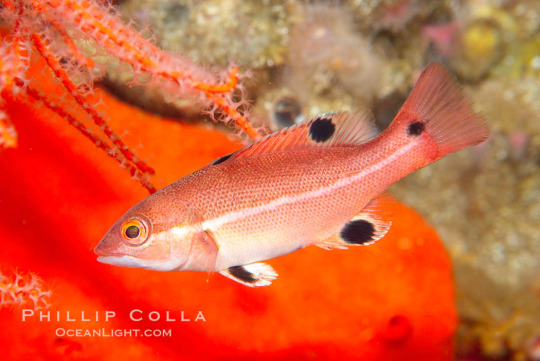
(Image: a juvenile Sheephead. It is a small, orange fish with a white stripe running from eye to tail and black spots on the pelvic, anal, dorsal, and tail fins. End ID)
The California Sheephead lives on rocky reefs and kelp forests from southern California to the Baja peninsula and Gulf of California. They prefer shallow water between 3 and 30 meters (10 - 100 ft) deep, though males will occasionally venture deeper. Sheepheads are predators that hunt hard-bodies invertebrates including urchins, shelled molluscs, and crabs. Juveniles hunt smaller prey such as sponges, bryozoans, and barnacles. The protruding canines give the fish a better grip when trying to pry food off of rocks. They crush the hard shells of the prey with sharp teeth before swallowing. The shells are then further ground down by the throat plates. Smaller individuals have been known to break open urchins too large to bit by picking them up and hammering them into rocks. Sheepheads play an important role in kelp forest ecosystems by keeping urchin populations down. Urchins eat kelp and without predators keeping their numbers in check, can reduce kelp forests to urchin barrens. Sheepheads are known to have a high site fidelity, meaning they will return to the same places over and over. They will maintains a sleeping spot (usually a crevice they can hide in or rock they can hide under) and return to the same places to hunt. They are diurnal and return to their sleeping spots at night to avoid predators.

(Image: a male Sheephead trying to pick up a sea urchin with tis mouth. End ID)
California Sheephead Wrasses are classified as vulnerable to extinction by the IUCN. Their primary threat is overfishing. The Sheepheads have been commercially fished since the 1800s and their numbers have dropped. The hermaphroditic nature of the species actually makes things worse. Commercial fishers are incentivized to catch the largest fish and the largest Sheepheads are the males and females that are likely to transition to male. Unlike with other species, there aren't small males around to make up for the loss of large males to fishing since the small fish are the females. The loss of males and the largest females (who are the ones most likely to transition to male) means there aren't enough males around during mating season to keep the population high enough. The introduction of marine protected areas and fishing regulations have helped the population recover. The loss of the Sheepheads is a big deal since they're one of the species doing the most to keep the kelp forests healthy by eating urchins. Natural predators of the Sheepheads include sharks, sea lions, and giant sea bass.

(Image: a fisherman holding a male Sheephead on a boat. The large canines of the fish are particularly visible. End ID)
#wet beast wednesday#transmasc icons#california sheephead wrasse#sheephead wrasse#wrasse#fish#fishblr#fishposting#pride#hermaphrodite#sequential hermaphroditism#protogyny#marine biology#biology#zoology#ecology#animal facts#educational#informative#image described
100 notes
·
View notes
Text

Semicossyphus pulcher - California Sheephead - Vireja de California
57 notes
·
View notes
Note
What fish do you think would be improved with adding teeth? And which one would be better without any?
California sheepheads and parrotfish need more teeth.
39 notes
·
View notes
Text

fishuary day 25 - fish skeleton
see the prompt list here
#fish#fish daily#fish skeleton#i think this is a sheephead? at least thats what google said#drawing#fishuary2024
273 notes
·
View notes